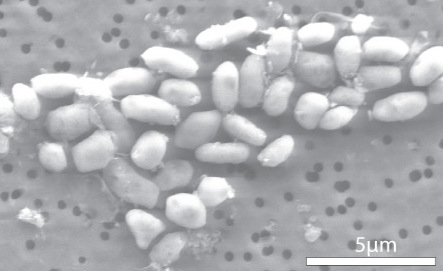Arsenic-Based Life?
January 5, 2011
Last year, I refrained from posting an article about
NASA's "discovery" of
arsenic-based
bacteria, since I was highly skeptical. Sure, I'm not an expert in the
life sciences; but I am a scientist, and I've read enough to have recognized
Sydney Brenner at an airport terminal several decades ago.[1] I do know enough about basic
biochemistry and error sources in
analytical chemistry to require overwhelming evidence when such a claim is made. It doesn't help that NASA has made frequent claims for
extraterrestrial "life" discoveries based on flimsy evidence, as I wrote in a
previous article (Life Everywhere NASA Looks? June 17, 2010).
The present controversy surrounds the paper, "A Bacterium That Can Grow by Using Arsenic Instead of Phosphorus," that appeared in
Science in December, 2010, by authors from the
NASA Astrobiology Institute, the
U.S. Geological Survey,
Arizona State University,
Lawrence Livermore National Laboratory,
Duquesne University and the
Stanford Synchrotron Radiation Lightsource.[2] Their claim is that a bacterium, a strain GFAJ-1 of the
Halomonadaceae, harvested from
Mono Lake, California, contains
macromolecules that contain arsenic as a substitute for
phosphorus; more importantly, their
DNA is built on an arsenate backbone, rather than phosphate. Arsenic, of course, falls below phosphorous in the
periodic table, so they're chemically similar. This discovery was trumpeted on the NASA Science News web site by an article with the title, "Discovery of "Arsenic-bug" Expands Definition of Life."[3] As the authors state in the abstract for the Science paper,
"Life is mostly composed of the elements carbon, hydrogen, nitrogen, oxygen, sulfur, and phosphorus... Exchange of one of the major bioelements may have profound evolutionary and geochemical significance."[2]

Halomonadaceae, GFAJ-1 Strain
(NASA image).
Mono Lake, which is an isolated lake, has water that is highly
saline and highly
alkaline, with high levels of arsenic. After harvesting the particular bacterial strain, the researchers were able to get continued bacterial growth in phosphorous lean, arsenic-rich, water. Analytical techniques were used to ascertain whether the arsenic was indeed incorporated into essential
cellular structures such as
membranes,
protein and
DNA. One critical fact is that the growth solution was not totally devoid of phosphorous. Norman Pace, a microbiologist at the
University of Colorado and an acknowledged expert in
astrobiology, has pointed out that the growth solution had a higher phosphorus content than parts of the
ocean known to support life. Pace was quoted as stating that the study was borderline fraudulent and should never have been published.[4]
Pace is not the only critic,[5,6] and a lot of the criticism seems a little too harsh. Some have criticized the paper as bad science, but it's hard for me to believe that such a large research team would not have been careful and self-critical. Some of my colleagues have given me important insights into problems with some of my own experiments. In science, such criticism is welcome. Science is self-correcting, and one of the correction mechanisms that no one mentions is that most published papers are never read past the abstract or subsequently cited. Most of the problem in the arsenic case is NASA's penchant for hyping such research, which may have affected the typical skepticism of the experimentalist. It's been said that no one believes a theoretical paper except the author; and everybody believes an experimental paper except the author.
Felisa Wolfe-Simon, lead author of the study, is providing bacterial samples to other labs for confirmation experiments, so the scientific process is working as intended. In an online statement containing a response to criticism of the paper, she writes,
"We look forward to working with other scientists, either directly or by making the cells freely available and providing DNA samples to appropriate experts for their analyses, in an effort to provide more insight into this intriguing finding."[7]
A very detailed technical criticism is provided online by Rosie Redfield, a microbiologist at the
University of British Columbia.[6]
References:
- For students of rhetoric, this statement is probably a variant of argumentum ad verecundiam.
- Felisa Wolfe-Simon, Jodi Switzer Blum, Thomas R. Kulp, Gwyneth W. Gordon, Shelley E. Hoeft, Jennifer Pett-Ridge, John F. Stolz, Samuel M. Webb, Peter K. Weber, Paul C. W. Davies, Ariel D. Anbar and Ronald S. Oremland, "A Bacterium That Can Grow by Using Arsenic Instead of Phosphorus," Science, Published Online December 2, 2010.
- Tony Phillips, "Discovery of "Arsenic-bug" Expands Definition of Life," NASA Science News, Dec. 2, 2010.
- Karen Kaplan and Eryn Brown, "Something's amiss with aliens and arsenic," Los Angeles Times, December 22, 2010.
- Marc Kaufman, "Study on arsenic-based life takes a beating on the Web," Washington Post, December 17, 2010.
- Rosie Redfield, "Arsenic-associated bacteria (NASA's claims)," ResearchBlogging.org, December 04, 2010.
- Felisa Wolfe-Simon, "Response to Questions Concerning the Science Article, 'A Bacterium That Can Grow by Using Arsenic Instead of Phosphorus'," December 16, 2010 (PDF File).
- Asking About Arsenic, Astrobiology Magazine, December 18, 2010.
Permanent Link to this article
Linked Keywords: NASA; arsenic; bacteria; life sciences; Sydney Brenner; biochemistry; analytical chemistry; extraterrestrial life; Titan life; Science; NASA Astrobiology Institute; U.S. Geological Survey; Arizona State University; Lawrence Livermore National Laboratory; Duquesne University; Stanford Synchrotron Radiation Lightsource; Halomonadaceae; Mono Lake, California; macromolecules; phosphorus; DNA; periodic table; carbon; hydrogen; nitrogen; oxygen; sulfur; evolution; geochemistry; Halomonadaceae; GFAJ-1; saline water; alkaline; cell; membrane; protein; DNA; University of Colorado; astrobiology; ocean; University of British Columbia; rhetoric; argumentum ad verecundiam.